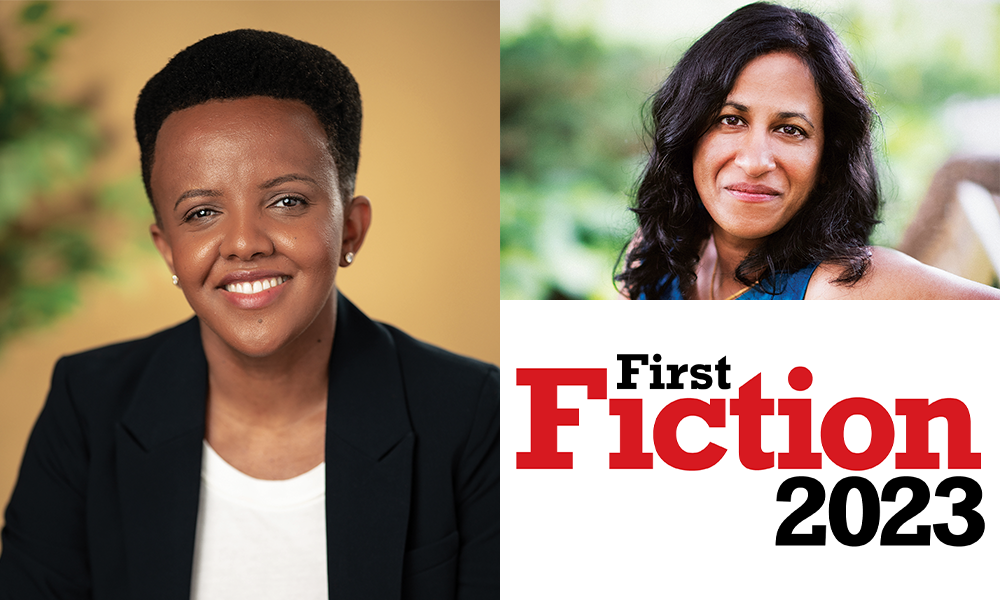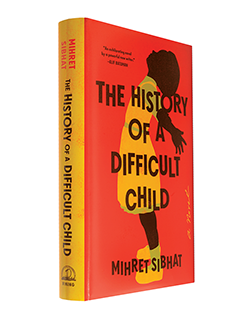Mihret Sibhat, whose debut novel, The History of a Difficult Child, was published by Viking in June, introduced by V. V. Ganeshananthan, author of two novels, most recently Brotherless Night, published by Random House in January. (Credit: Sibhat: Dena Denny; Ganeshananthan: Sophia Mayrhofer)
![]()
Mihret Sibhat’s debut novel begins with God dumping rain on a small Ethiopian town as though He were mad at somebody. The resulting flood carries detritus to the Small River, which passes things along to the Medium River, which hands the lot off to the Big River, and before we know it we, too, are swept away, caught in the force of that water, in the force of those sentences, which take us right to Selam Asmelash, the irresistible and unforgettable heart of the story—a not-quite-a-child narrator busy making her way into the world.
“I am the little terrorist who managed to fuck with an entire town’s head before I was even born, and this is my story,” Selam says. This line has stayed in my head. As Selam narrates the story of her once-prosperous family navigating socialist political upheaval in the 1980s, she can’t help but be blunt, outlining with savage wit and undeniable tenderness the thousand hypocrisies of the political and personal jockeying around her. The smallest child in her sizable family, Selam somehow manages—relentlessly, like that flood—to pose big questions about politics, power, and faith. Mihret Sibhat has written a novel that seamlessly and audaciously teaches us to play by its rules and to read along at its merciless, fluid velocity. It’s a book that will make you feel like you must keep up with it and that there’s nothing you’d rather do.
One of the most astonishing things about your book is the voice. The narrator is a child, and even though Selam has little control over her world, she has command of the story. How did you think about approaching her perspective, and what were the most exciting and challenging parts of navigating this point of view?
When an adult narrates a story, we don’t really think about how much credit for their wisdom belongs to their child self. The wisdom essential to survival—“do not touch fire” and “be careful when walking down stairs”—is learned through sacrifices made by the child. And yet even when the child is part of the story, we see her only through the somewhat filtered retrospective gaze of the adult. Letting Selam tell her own story was a way of addressing this fundamental unfairness. And when she needed support to tell her story successfully, it seemed just to put everyone—God, her grown selves, the surveillance state, the institution of gossip—at her service. But she’s still a child; she can’t carry everything, so occasionally she wisely passes the microphone to others. The most exciting aspect of spending time with Selam was seeing my freedom expanded, going places that I am not allowed into as an adult. I could get away with expressing harsh takes on parents, being vulnerable without the fear of looking ridiculous, and being freely earnest about things and not feeling the need to always be witty or subtle. Moreover, because the novel is semiautobiographical, seeing Selam grieve the tragedies of her life allowed me to look at mine anew; it gave me permission to cry over things that happened decades ago. The biggest challenge in writing Selam came in the need to know when to say, “This part of the story isn’t something my voice can carry; I need to let someone else do the job.” That problem was solved when I decided to incorporate other points of view.
I know humor has been a priority for you since early on. Can you talk a little bit about that? Were there parts that weren’t funny and became funnier, or the other way around? I especially love the conversations and conflicts among the family, as well as the town’s gossiping and your sharply chosen metaphors.
Like Selam’s voice, humor was my essential instrument for reaching what Elena Ferrante calls “literary truth.” Without it I don’t think I would have succeeded in turning the tragedies of my childhood into a novel. I see the difference between factual events and a work of art as the difference between a shelter and a home. The former can be any structure with a roof; the latter evokes a feeling because you have made aesthetic decisions in making it. In my novel, humor is the primary ingredient that raised the tragic raw materials of my childhood to a level of art. Whether it is good art or not is a different story. By giving me a chance to approach grief from an oblique angle, humor helped me see old stories anew. It gave me an incentive—entertainment at least—to write about stories that I thought were just painful and held no value for readers. It functions both as a literary device and a therapeutic device that gave me the courage to face my grief. Once the humorous tone of the book was set in the early chapters—with the speculations surrounding the child’s conception and birth—Selam and I felt empowered to make fun of anything and anyone, including her mother’s disease. That freedom allowed us to not be threatened when we came across something that felt purely tragic: We simply embraced the sadness. I did not pressure myself to make everything funny; humor and tragedy worked in symbiosis, coexisting or sometimes yielding the page to each other.
The grief and humor you’re describing appear frequently in moments connected to faith, especially as Degitu, Selam’s mother, becomes ill. How did you think about humor and irreverence in relation to some characters’ reverence for God?
In the culture I grew up in, grief and God share some traits, like unassailability and fearsomeness. Children were forbidden from holding their heads with both hands, for example, because it is something adults do during mourning, as they wail for the dead, and to do so in peacetime is to summon a bad omen. Naturally, for rebellious types like Selam and me, such forbidden matters are fertile grounds for staging our uprisings—not out of need for rudeness per se, but for survival. So in those moments when grief and faith appear together opposite Selam, threatening to suffocate her, she cannot walk into that space empty-handed; she must bring her irreverence, her humor.
Which writers on your bookshelves do you think are particularly good at depicting belief?
My books are currently in boxes in a friend’s basement, unfortunately, so I can’t look at them and refresh my memory. But a chapter in We Need New Names by NoViolet Bulawayo, and Foreskin’s Lament by Shalom Auslander come to mind, and I remember thinking how hilarious and relatable the latter is even though it is a memoir of an Orthodox Jew. My family’s Evangelical Christianity was a site of immense trauma for me, so the only way I can stand to read literature dealing with any religion for now is if it’s funny.
I know this book was originally conceived as part of a longer story, and I’d love to hear more about what’s to come for Selam.
This book was intended to be the first of a trilogy. I was going to follow it up with the stories of the teenager and the woman. However, for a reason unknown to me, the teenager is refusing to talk. Perhaps I’ll spend some time trying to understand what she wants, looking for an entry point into her story. Or I’ll leave her alone and move on to something else.
An excerpt from The History of a Difficult Child
On a rainy morning in August, a month ahead of the tenth anniversary celebrations of the revolution, a group of women gather at a house in the center of town to drink coffee, eat bread, and marvel at a thing that’s been growing inside the troubled belly of Eteyé Degitu Galata, the former feudal landlady who lives in the green house next door but is clearly too good to join her neighbors for coffee.
“It can’t be a child, can it?” they whisper amongst each other.
“No, it can’t be. She has that disease that’s been making her bleed for over a year now.”
“You don’t get pregnant while bleeding.”
“No, you don’t,” they say. “No, you don’t.”
There has been confusion in town over the question of how to deal with Degitu’s situation. Ever since the news of her abnormal bleeding got out—there was an incident involving a soiled habesha qemis at a wedding—women of the neighborhood have been sympathetic, her sickness having sucked the vigor out of their revulsion for that aristocratic louse. The revolution has spent the last decade teaching people how to hate the former landed gentry: sometimes, farmers marching through town would pause in front of Degitu’s house, chanting “Death to bloodsuckers!” and forcing her and her husband to lock up their doors in fear. The revolution has offered no instructions on how to behave when former bloodsuckers start bleeding themselves. Women of the town don’t know what to do, and it isn’t just a matter of figuring out one’s moral stance; there is also confusion over whether expressing sympathy for people like Degitu amounted to a counterrevolutionary act.
Degitu and her family are not entirely isolated from the community—she has been to the same funerals, weddings, and baptisms as the Women. She’s also a member of the town’s Mahber, an association of Christian women, where she is known for her dedication to service, inserting her imperialist face at every event, arriving at functions ahead of everyone else, taking on cooking duties never even assigned to her. That is sometimes more annoying than her past as a landlady who made her tenant farmers cough up the last cup of grain she was owed. It is more annoying than the fact that, despite losing her large tracts of land, her coffee farms, her businesses and two homes, she lives in a house with an elevated concrete foundation, multiple rooms, and cement floors. At least that house isn’t what it used to be: the exterior is the kind of green you would get if trees could shit and had diarrhea. It hasn’t been green in the truest sense since Degitu spent what must have been the last of her monies on a sewing machine. (Or maybe that is what she wants people to think: those former feudal lords might sometimes wear pilling sweaters with missing buttons, but they could be hiding a stash of gold bought at a discount from people who have fallen on hard times.)
The point is: despite not joining her neighbors for coffee, Degitu is very much part of the community. The problem is: everyone knows the list of counterrevolutionary acts is a living list, so although it has been mostly safe to interact with Degitu so far, things might change tomorrow. Even seemingly upstanding citizens who have always been poor might turn out to be members of some counterrevolutionary movement. So much happens in secret, which is strange because in a town as big as a bull’s forehead you think you would know everyone. You only get a full picture of your neighbors when they get arrested or, in the case of those who haven’t been seen since the Red Terror, completely disappeared. You have to always be alert and ready to abandon people, for anything that’s good today might turn out to be counterrevolutionary tomorrow.
From The History of a Difficult Child used with the permission of the publisher, Viking. Copyright © 2023 by Mihret Sibhat.











